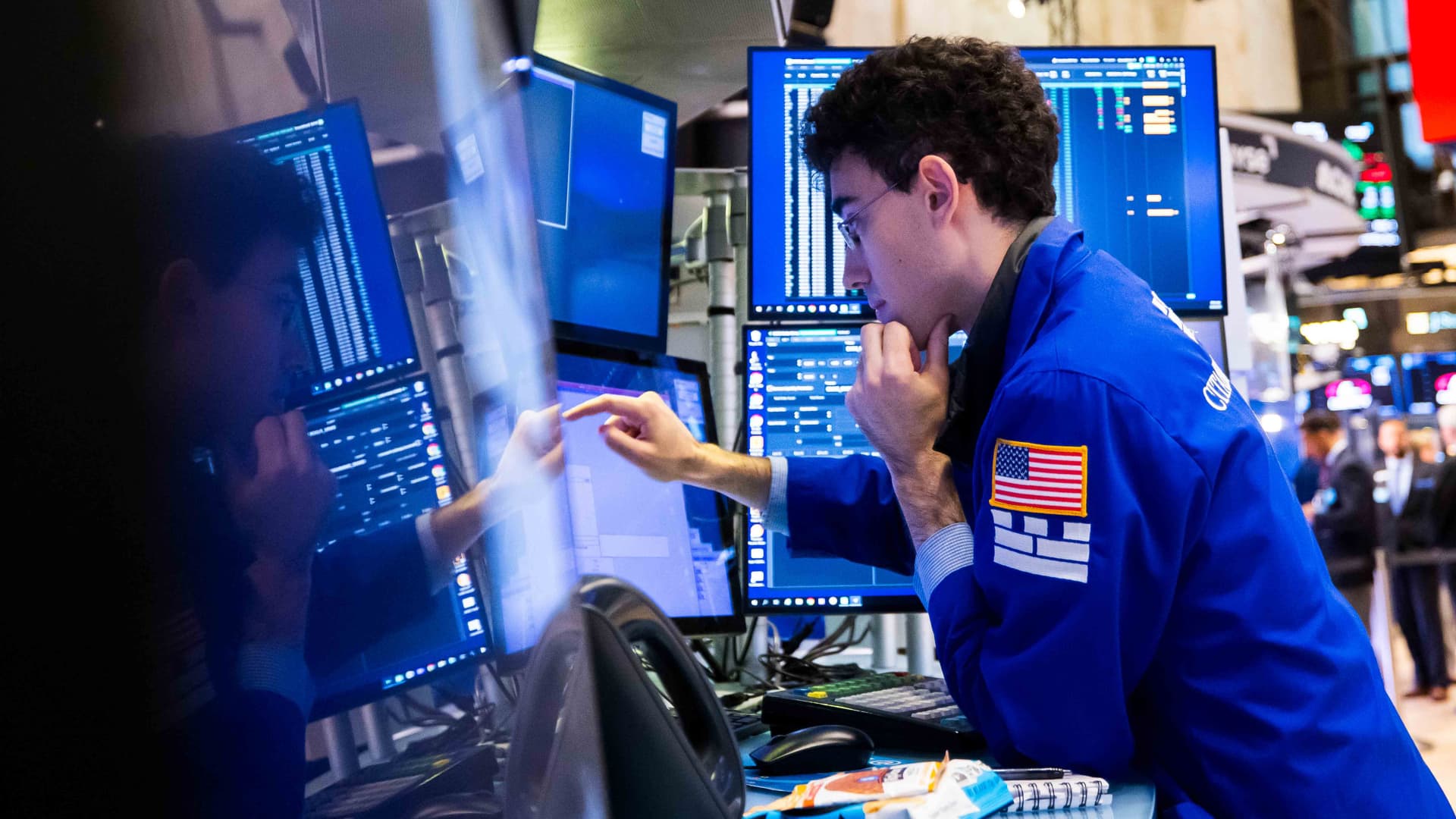One person’s pessimism is another’s pragmatism. As a tough first quarter skids to a close, a crucial market debate is whether the recent mass outbreak of gloom is an overreaction to ambiguous economic and market signals, or simply a clear-eyed recognition that real-world conditions are souring fast. For anyone who has been around markets long enough, it’s tempting to view the societal foul mood evident in surveys as overdone relative to the damage done so far to stock prices or the real economy. Evercore ISI strategist Julian Emanuel points out that the Conference Board’s polls of both consumers and CEOs are “nearing pandemic levels of pessimism.” The most widely tracked weekly survey of individual investors, by AAII, has logged more than 50% bears for five straight weeks, something only ever seen near the depths of raging market routs. All this, with unemployment at a slim 4.1%, the S & P 500 a mere 9% off an all-time peak and corporate profits still growing. .SPX 1M mountain S & P 500 in past month To Emanuel, the apparent mismatch between feelings and his view of fundamentals suggests it remains a “buyable correction in an ongoing bull market.” A defensible position, for sure, though the market’s underwhelming response to what seemed a pretty good rebound-rally setup since the mid-March 10%-correction low hasn’t helped that case much. To recap: The S & P 500 underwent one of the sharper 10% gut checks in memory over three weeks into March 13, before pivoting higher with two days of broad, encouraging buying, followed by another decent pop last Monday on hopes of a more moderate tariff campaign. Since then, it’s been a lot of messy churning in a headline-sensitive, irresolute tape. No more than 40% of the total pullback was ever recovered, before last week’s late sell-off on stiff auto tariffs and disappointing consumer-spending and inflation readings. The extremity of the negative attitudes right now has Wall Street acutely sensitive to any evidence that such “soft” survey results are bleeding into the measured “hard” data tracking real activity. This helps explain the markets’ severe response to Friday’s modestly weaker-than-forecast personal-spending numbers for February, joined with another sticky-high core PCE inflation print. Treasury yields rushed lower to effectively price in a higher chance of broader economic weakness – which the Federal Reserve might or might not feel empowered to offset with a timely rate cut due to those uncooperative inflation numbers. Given all this, I’m glad I mentioned here last week that market bottoms are a process not a moment, that 40% of 10% corrections deepen to at least 15% even outside of recessions and initial correction lows frequently need to be retested over a number of weeks. In this context, the index retracing most of its snapback bounce is fairly typical. Of course, it’s called a “retest” because sometimes they fail. Frank Cappelleri of CappThesis on Friday asked a kaon-like question: “Was the back half of March a failure to go up … or a failure to go down? In other words — which side has been more frustrated by the lack of net movement?” There’s plenty of frustration to go around, it would seem, and one could argue that given the unsettling news flow, chopping sideways for two weeks might not be so bad. As the correction hit 10%, bulls saw an oversold market, solid corporate-credit conditions, widespread pessimism and a helpful washout in overextended momentum stocks — along with seasonal factors that were supposed to turn positive in mid-March. The bears are eating just fine for now, but only if they bet against the biggest and highest-quality growth stocks, and they likely feel the market is still blithely ignoring the policy risks. BTIG technical strategist Jonathan Krinsky had been calling for a tactical rally into April starting more than two weeks ago, though on Friday said the recovery attempt had become “hard to defend.” One issue shadowing the bull case is the way once-reliable leadership groups have faltered, surrendering the benefit of the doubt they had enjoyed for more than two years. “Outside of precious metals,” Krinsky said, “it’s hard to find many groups in uptrends. This lack of leadership makes it difficult to defend a bullish stance outside of small bounces.” Scarcity of outperformers The once-indomitable “Magnificent Seven” is down 15% year to date. Semiconductors have surrendered half of their post-ChatGPT gains. Homebuilders are back to late-2023 levels and transports have been dead money for 18 months. Financials, utilities and energy act better. Within the industrial sector, aerospace and defense looks sturdy. The S & P 500 communication-services group is still firmly in an uptrend and trying to hold above its Election Day level, thanks largely to its purely defensive telecom components. These are places to hide, or hunt, perhaps. But these clusters of relative strength are probably too small collectively to drive the broader indexes too far. Of course, one investor’s scarcity of outperforming leadership sectors is another’s abundance of beaten-down comeback candidates. Nearly half of all S & P 500 stocks are more than 20% off a 52-week high. One way of looking at the first quarter is as a sloppy rotation toward value and foreign stocks that’s worked to reset elevated investor expectations and CEO complacency. The S & P 500 value index is off just 1% this year versus a near-9% loss for growth. When it comes to tech, however, a return to outperformance could be tough. Ned Davis Research looked at all years when the tech sector lagged the S & P 500 in the first quarter by at least four percentage points. The chart here shows the average path of relative tech performance in those years, a picture of continued struggle. On a more fundamental level, the Nasdaq 100 – of which the Magnificent Seven make up more than 40% – hasn’t had much of a valuation reset when gauged by expected free cash flow. For years, one bullish take on megacap growth stocks was that, even though they had high price-to-earnings ratios, almost all the earnings were free cash flow given the high margins and “asset-light” business models. Yet the likes of Microsoft, Alphabet and Meta Platforms are spending so heavily on AI infrastructure that more profits are funding capex rather than falling into free cash flow. This might work out fine if all the AI capacity proves an accelerant to these companies’ growth in coming years, as they clearly are betting. That’s the “if” that markets are struggling with mightily right now, as Nvidia shares near 10 months of no net progress, the CoreWeave IPO required a stiff discount to the anticipated issue price, and Microsoft is trading at a price first reached just after Thanksgiving 2023. The staticky technical and fundamental atmospherics around Big Tech don’t have much to do with the suspense over the April 2 White House deadline for a new set of “reciprocal” tariffs. Yet tariffs are standing in as the convenient focal point for nearly all other relevant investor worries: Perceived risks to growth and inflation, as well as wariness around erratic or capricious policymaking that is keeping businesses off balance and upending global alliances. Such a pileup of feared negatives suggests at least remaining open to ways that things might turn “less bad.” Could the April 2 tariff deadline prove a psychological clearing event for stocks that culminates this correction phase? Might next week’s jobs report reassure investors that the labor market is resilient? And has the market’s setback lowered that bar enough for first-quarter earnings to act as a source of relief? All pragmatic questions in a moment of piqued and pervasive pessimism.





